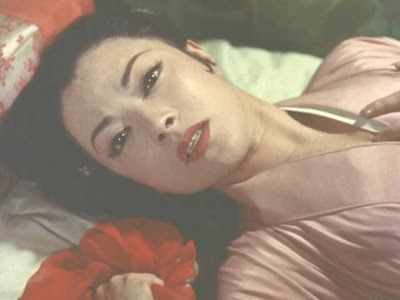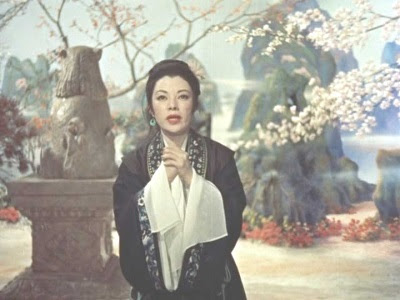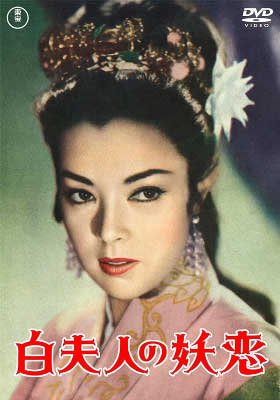Madame White Snake
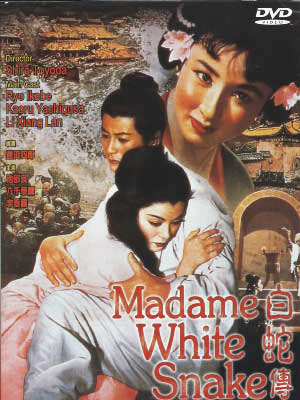
Director: Shiro Toyoda
Year: 1956
Rating: 8.0
Aka: Legend of the White Serpent
In nearly every country in Asia there are
folktales of snakes which can take on the female human form. And films from
India to Hong Kong to Korea to Japan have been based on this. The most famous
story is that of the White Snake, one of China's four main folktales. There
have been various versions of this in film and on TV - the first was produced
by the Shaw Brothers in 1926 when they were still based in China. Shaw Brothers
produced another version with Linda Lin Dai as the title character in a Huangmei
Opera in 1962. Then of course the wonderful Green Snake with Maggie Cheung
and Joey Wong in 1993. A lesser known one but a favorite of mine is the Jade
Leung film Phantom of Snake in 2000. This one is a co-production between
Shaw and Toho set in China but with an all-Japanese cast and spoken in Japanese.
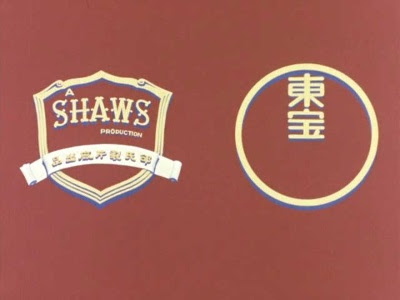
The folktale goes back centuries. The basic
gist is that a white snake spirit in the water digests a magic immortal pill
and takes on powers. Later she sees a man about to kill a green snake and
saves it by transforming into a woman. The green snake is grateful and they
become sisters. Years later she meets the man who threw the pill into the
water when he lends them an umbrella in the rain and they fall in love. But
a Taoist monk - who according to the folktale was once a terrapin in the
same waters that the snake spirits were - wants to reveal her to the husband.
When he succeeds the husband dies of the shock. What? I have been having
great sex with a snake? But the two snakes go to heaven and get the cure
to bring him back to life. He still loves her. Which is the way it should
be. No doubt the Culture Warriors on the Right would be upset but if a man
and a snake are in love, is it anyone's business? Let them be. But the religious
right of any era has to interject their morals. In ancient China or today.
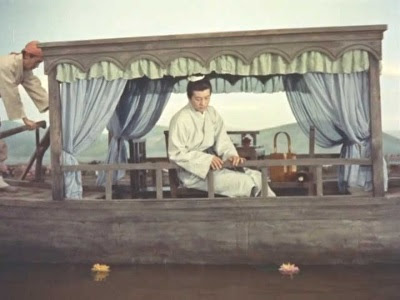
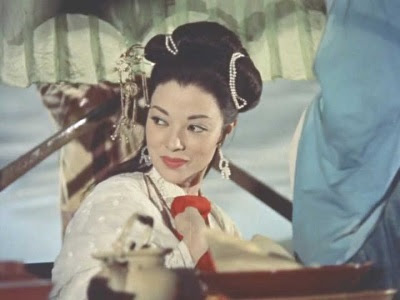
The film is absolutely gorgeous. The colors
are deep, saturated and full and dazzling. The period sets are just beautiful
with lovely detail, lakes, homes, streets and outside scenes of lush flowery
landscapes - all shot in the studio in Japan. Shaw had co-produced another
film with a Japanese studio - Princess Yang Kwei Fei in 1955 with Daiei.
At the time the Shaw Brother's main business was still in Singapore and they
were in no position to shoot a film like this. In 1946 Runde Shaw had returned
to Hong Kong after the war was over and took over his old film company Nanyang
and re-named it Shaw Studio. He decided that they would start making their
films in Mandarin because he felt there was a bigger overseas market for
those and Hong Kong was now a beacon for those fleeing the Communists. There
was also a large Cantonese film industry to compete against. From 1952 to
1957 Shaw produced about 70 Mandarin films but they did not do that well
against two other Mandarin studios - MP & GI (Cathay) and Great Wall
(a left leaning studio). Run Run came over from Singapore in 1957 to run
the movie business and bought a plot of land to build the famous Shaw Studio.
The glistening artificial look of the indoor sets of this film is certainly
something that Shaw would emulate within a few years in their studio.
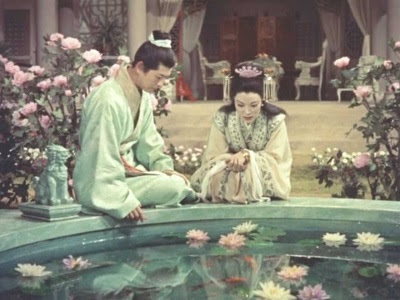
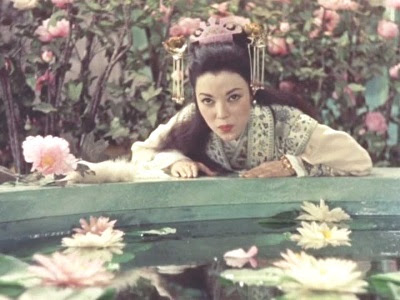
The film begins when Xu Xian (Ryô
Ikebe) is being taken in a small taxi boat and it begins to rain. He sees
two women on shore asking for a ride and he directs the boatman to do so.
These women are Madam Bai and her servant Xiao-Qing (Kaoru Yachigusa). They
are thankful and invite him to their home which is stunning with its fountain
and flowers. She drops a pearl on top of a flower blossom in the fountain
and blows it towards him. As sexual as it sounds. She declares her love for
his pure heart and though he declares that he is not worthy being a poor
man, she doesn't care and gives him money to end his apprenticeship. Unfortunately,
our two girls stole it from a bank the night before and Xu Xian is arrested
and they do a quick getaway - and the lovely house has become a decaying
dusty wreck.
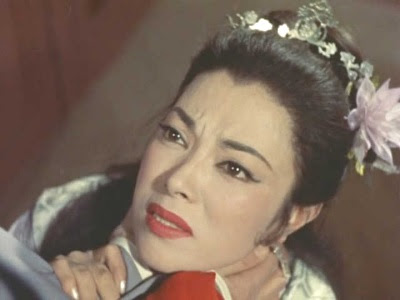
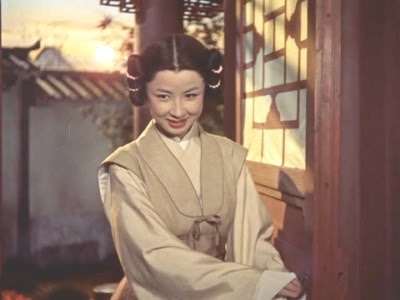
That should have probably given him a clue
that something was amiss. But it is usually ghosts who pull that trick. He
is let go to live in another town working for a relative - and guess who
shows up. They convince him it was all a mistake and he is overtaken by passion
and picks her up and carries her to the bed. In the folktale she gets pregnant.
All goes well after they are married - yes, business is bad selling medicine
but Madame Bai takes care of that by poisoning the town's water supply. As
she explains to her maid, I do it for love. Well, in that case. There are
duels between her and a monk and she creates a tidal wave that killed people.
But again, she did it for love. The film is very formal but there is a sexuality
laying right beneath the surface - between the couple but the maid seems
to be sexually frustrated watching them get it on.
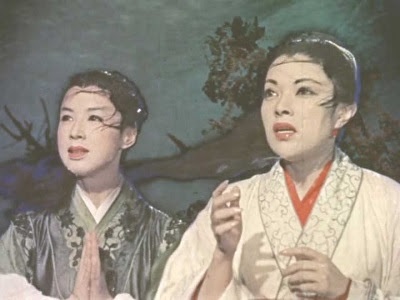
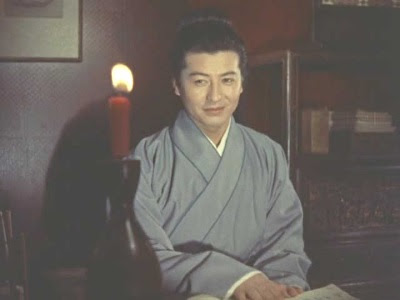
Madame Bai is played by Yoshiko Yamaguchi
better known in the West as Shirley Yamaguchi. She had some life. Born in
Manchuria to Japanese parents - her father worked for the South Manchuria
Railroad. Growing up she learned Mandarin and appeared in Chinese films as
Li Hsian-lan. She became a star in the Manchukuo film industry usually billed
as Chinese. One of the films she made in 1940 called China Nights in which
she plays a debased Chinese woman in love with a Japanese man got her so
much hate that the song she sung in it, Suzhou Serenade was banned later.
At the end of the war, she was sentenced to death by firing squad for being
a traitor by the government and only escaped because her Japanese identity
was proven at the last minute. She left China and moved to Japan where she
took up her acting career. She made a few films in Hollywood, using the name
Shirley - Navy Wife, House of Bamboo, Japanese War Bride and appeared on
the Red Skelton Show. She retired in 1958 and became a host on TV and then
in 1974 was elected to the Japanese Parliament. She passed in 2014.
Note - the Shaw information came from the
book The Shaw Screen.











